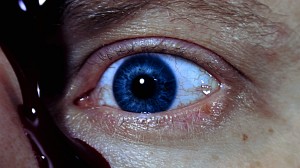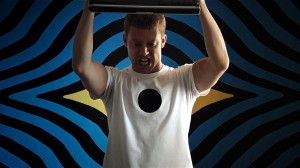By Paolo Benetazzo
Push The Boundaries of Your Creativity: How I Made the Film Study
Filmmaking is my day-long obsession, joy and torment
When you can’t see the line between fiction and reality, filmmaking becomes your lifestyle.
I was a psychology student when I came up with the concept behind my feature film directorial debut Study. During my final year at university I was involved in a number of film projects, including short films and documentaries. I didn’t have full artistic control. I had to compromise my vision for the sake of the team and that was the only way to get it done.

When you don’t want to share your vision with others I think you’re ready to make your full-length film, no matter what your budget is. I would rather make a low budget film instead of collecting short films or waiting for the great opportunity that might never come. It’s going to be risky, painful and insane but that’s how real indie films are made.
I’m a self‐taught filmmaker, I’ve never attended a film school. Watching films along with real life experience represents the film school par excellence in my opinion. Films are the greatest teachers of all; they are an endless source of learning.
The Open Screenplay
Fascinated by the study of psychology and its impact on modern life, I decided to explore my studies in a feature film. Once I graduated in Psychology, I moved to Ireland where I started writing the script in English. I was discouraged by the Italian film industry. There’s no such a thing as independent cinema in Italy. All you can see is the same old industry made by the same filmmakers and actors. With the exception of a few rare cases, Italian producers don’t usually invest in new ideas and don’t really believe in new ways of making cinema.
I left the screenplay open for the entire production. That was essential for my film. It gave me the chance to improvise during the shots, fix bad acting and rewrite scenes that would have been too expensive to film.
Scientific journals, experiments and researches used in the film are all fictional. I created them from scratch to avoid copyright issues. The story and the characters are also original. It’s getting really tough these days for an indie filmmaker: the competition is just shocking, so writing something original was extremely important to me. I don’t know if I did, but I badly wanted to make a film distinguished by a unique expression of creativity.
Synopsis
 Study is a psychological thriller drama film, which follows a psychology student in the last week before his final exam, discovering his life and exploring his mind. Starting on Monday, in the middle of his room, the student tries to study surrounded by his past and his present, obsessed by the concept of life and death, and tortured by the eternal struggle between science and religion. As the days go by, unexpected characters and situations interfere with the student, turning what was meant to be a regular week of study into a complete nightmare.
Study is a psychological thriller drama film, which follows a psychology student in the last week before his final exam, discovering his life and exploring his mind. Starting on Monday, in the middle of his room, the student tries to study surrounded by his past and his present, obsessed by the concept of life and death, and tortured by the eternal struggle between science and religion. As the days go by, unexpected characters and situations interfere with the student, turning what was meant to be a regular week of study into a complete nightmare.
Shooting Without a Film Crew
I worked in a clothing store at the time I was writing the script. Working full time and writing during the night was ok, but when it came to shooting I had to quit my job and invest all my savings. The film was produced on a budget of approximately $10,000. Since rent and bills were the first obstacles, I got all the shots I needed in Ireland and right after I moved back to my house in Italy.
It took me almost a year to build the main set in the mansard roof. It was the study room in the film. Most shots were taken there. I literally lived, slept and created on that set. Even the film score was composed there. I made two wall paintings symbolizing two eyes. They appear in several scenes, including the theatrical trailer. The study room was big enough for steadicam and dolly shots.
The film was entirely shot without any film crew. When I really needed someone behind the camera I called my mother or a friend, otherwise I was always on my own. The standard procedure included countless tests with me in the frame. I performed in front of the camera and right away I checked the shot behind the camera. I didn’t have a monitor on the set; I could properly view the footage only in my editing suite. Many times I had to reshoot the whole scene because of the blur or problems that I couldn’t notice during the shot. That was extremely painful and frustrating. You spend a large amount of time shooting a scene, you’re satisfied with performance and camera angle, but when you watch it on a 23’’ screen you discover things that ruin the shot. As it wasn’t enough, at that time I was shooting in HD on an 8 minutes P2 card with the Panasonic AG-‐HVX200. I was forced to stop filming and downloading the card every 8 minutes of footage.

I shot my extreme close ups and body movements wearing a steadicam vest, while I used a wheelchair for the dolly shots. The camera was mounted on the wheelchair and was usually pushed by my mother. She was in her 60’s, but she achieved some really smooth shots at the end. When you can’t afford professionals, it’s all about continuing to try until you get the good shot. You need time though, you can’t think of making a feature film in a few months under these circumstances. Study comes from a long introspective and experimental work developed over a period of five years (development-post-production).
Influenced by unconventional filmmaking techniques, I used unknown actors, friends and family in the cast. I found great outdoor locations such as Trinity College and Garden of Remembrance in Dublin, where I shot with a film permit at zero cost. Making this movie was like living a dream in hell: the budget was ridiculous, the film crew was nonexistent and I had no connections whatsoever. The experience was so extreme that I thought about quitting on several occasions. However, in an era of independent films made on high budgets with hundreds of people, my film is distinguished by a profound cinematic individualism with one person behind it. Study is a true independent film.
Music Plays a Vital Role in Study
Study does not rely on traditional techniques of narrative cinema. I wanted the film to be a primarily visual and sound experience in which music plays a vital role in evoking specific atmospheres.
I spent a year composing the music and searching for the right sound. At first I wanted to use famous modern songs, but the cost was unaffordable. It was actually insane, a minimum of $60,000 for less than a minute. At that point I decided to compose an original score with two friends of mine. They were both musicians and one of them owned a recording studio. Since composing the music in the studio was too expensive, initially we played and recorded in the film’s main set. My friend played a Gibson Les Paul using a vintage Marshall amp plus multi-effect pedal and I recorded into my laptop through a cheap mixer. I was interested in a variety of music genres including hard rock, psychedelic rock, new age, funk rock, gothic rock, trash metal. We later added bass, Rhodes piano and a number of sound effects in the studio.
The film also features several famous pieces of classical music including Un Sospiro and Piano Concerto No. 2 by Liszt, Funeral March and Nocturne in E Minor, Op. 72 by Chopin, Prélude à l’après-midi d’un faune and Arabesque No. 1 by Debussy, L’usignuolo by Respighi, Prelude to Act 1 Lohengrin by Wagner. Some pieces were as usual too expensive, so I hired two pianists and recorded the versions I needed. That way I owned the rights, I could publish the music and it was still much cheaper than buying a synchronization license for each track.
The soundtrack album was released on iTunes on October 1, 2013.
Film Release
 Study premiered in London on September 1, 2012. The film has been screened and awarded at several international film festivals including the California Film Awards, Portobello Film Festival, Indie Fest, Accolade Competition, Los Angeles Movie Awards, SoCal Film Festival. Study has since developed a cult following, due to underground popularity (over 16k fans on Facebook and Twitter).
Study premiered in London on September 1, 2012. The film has been screened and awarded at several international film festivals including the California Film Awards, Portobello Film Festival, Indie Fest, Accolade Competition, Los Angeles Movie Awards, SoCal Film Festival. Study has since developed a cult following, due to underground popularity (over 16k fans on Facebook and Twitter).
As of 2014, the film is still screening at film festivals worldwide.
External links
Movie Site, Trailer and Awards: www.studythemovie.com
Facebook : www.facebook.com/studythemovie
Twitter : twitter.com/studythemovie
Soundtrack album on iTunes: itunes.apple.com/us/album/study-‐original-‐motion-‐picture/id720983425
Film production company and filmmaker site: www.arttouchesart.com





